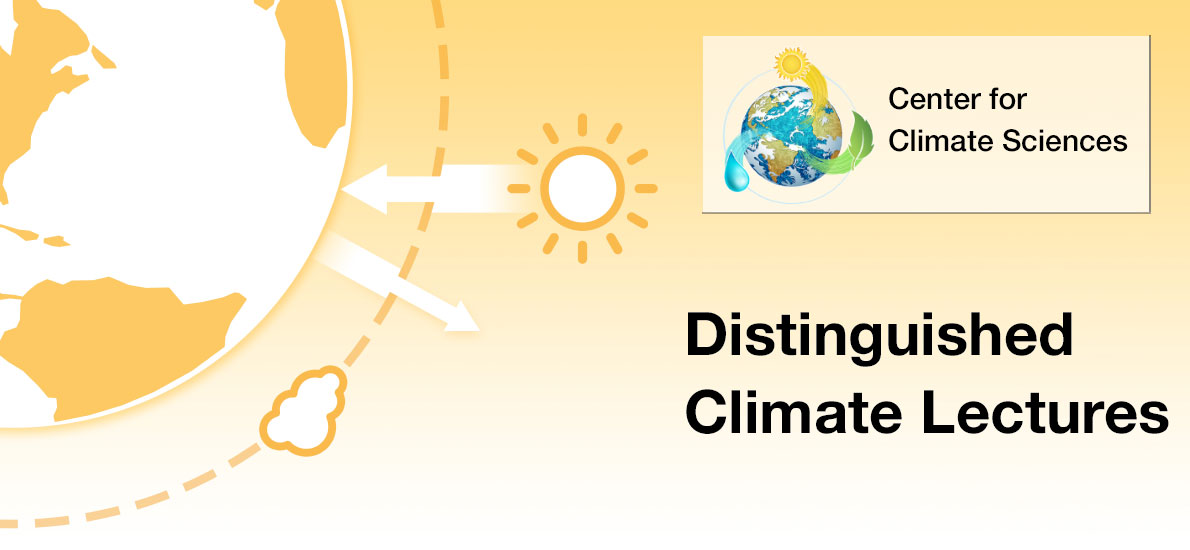Seminars
A Machine Learning Approach Toward a “Seamless” Understanding Droughts, Heatwaves and Fire Weather from Sub-Seasonal to Decadal Scales
May 19, 2021
| WebEx, 9:00am PT
› view lecture

About this Lecture

The National Earth System Prediction Capability (ESPC) aims to improve earth system prediction from sub-seasonal to decade scales, with emphasis on “seamless” prediction. Yet, our understanding of weather-climate connection, especially in a changing climate, is still in its infancy. For example, it is not clear what weather patterns are responsible for dry spells and heat waves during the warm season over continental United States (US), and which of these patterns are responsible for extreme droughts and stronger and longer fire season? How do decadal climate variability and anthropogenic forced climate change affect the intensity and frequency of extreme fire weather?
In this lecture, I will report our recent and ongoing studies to explore these questions through machine learning approaches. To assess the influence of weather patterns on droughts and fire weather, we use multivariate Self-Organization Map to characterize the weather patterns responsible for dry and wet spells, their associated atmospheric thermodynamic condition and moisture transport, and their contributions to warm season droughts and decadal variability of the land surface aridity and fire weather. We also use a constructed flow analogue approach to determine the relative influence of natural climate variability and anthropogenic forced change on the increase of heatwaves and fire weather in recent decades over Western US, including those that contributed to the 2020 August Camp Fire, California’s largest wildfire on record.
The analyses suggest that, although many weather patterns can contribute to dry spells and moderate droughts, extreme droughts are largely caused by an increased frequency and persistence of a few leading weather patterns that are responsible for strong dry spells climatologically. Thus, understand the causes behind the changes of these few weather patterns is central for determining predictability of the extreme droughts. On the other hand, for the same weather patterns, the probability distributions of surface temperature and vapor pressure deficit (VPD) in the recent decades have changed significantly over the western US, leading to higher probability of heatwaves and fire weather, compared to earlier decades. Consequently, at least two-thirds of the increase of the fire weather over western US during recent decades is attributable to climate change, whereas only one third or less of the increase of fire weather is attributable to changing weather patterns. Thus, climate variability and changes can have significant impact on weather and sub-seasonal forecasts.
About

Dr. Rong Fu is a climate research and a professor in the Department of Atmospheric and Oceanic Sciences, University of California, Los Angeles. Her research focuses on the mechanisms that control droughts, rainfall seasonality and variability over Amazonian and North American regions, and how changes of global climate, local vegetation and biomass burning, and oceanic decadal variability have influenced these processes in the recent past and will influence rainfall seasonality and droughts in the future. She has also developed a drought early warning for US Great Plains working with regional water resource managers. Her research is among the earliest to observationally uncover significant roles of tropical rainforests in determining rainfall seasonality over Amazonia and Tibetan Plateau in determining water vapor transport to global stratosphere; She received NSF CAREER and NASA New Investigator Awards, is an elected fellow of the American Meteorological Society, the American Geophysical Union and the American Association For the Advancement of Science, respectively. She was the President of the Global Environmental Change Focus Group (2015-2016) and Leadership Team of the American Geophysical Union Council. She has served on many national and international panels, such as the National Research Council special committees on “Abrupt Impact of Climate Change” and “Landscapes on the edge”, the Climate Working Group for NOAA Science Advisory Board. She is a co-leader of NOAA Drought Task Force Phase IV and an Editor of Journal of Geophysical Research - Atmosphere.
